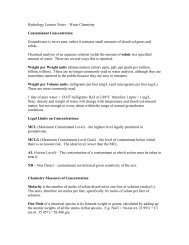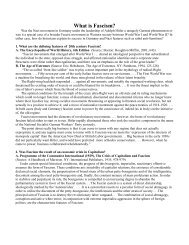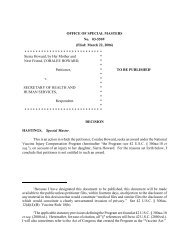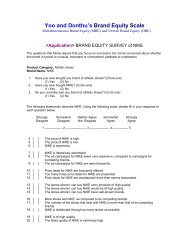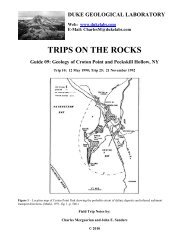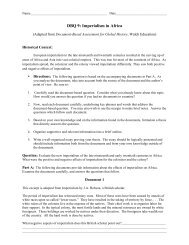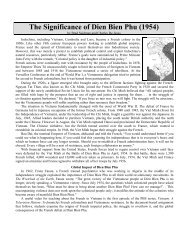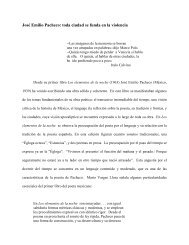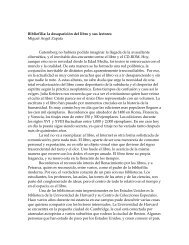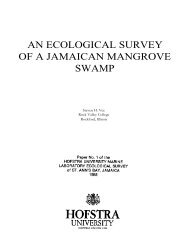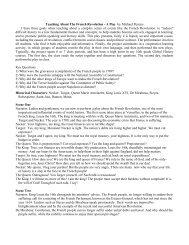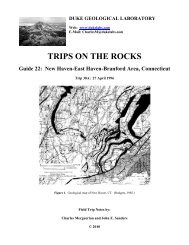Middle School Museum of Slavery Project - People Page - Hofstra ...
Middle School Museum of Slavery Project - People Page - Hofstra ...
Middle School Museum of Slavery Project - People Page - Hofstra ...
You also want an ePaper? Increase the reach of your titles
YUMPU automatically turns print PDFs into web optimized ePapers that Google loves.
<strong>Middle</strong> <strong>School</strong> <strong>Museum</strong> <strong>of</strong> <strong>Slavery</strong> <strong>Project</strong><br />
by Stephanie Hunte, Rachel Thompson and Robert Kurtz<br />
We were able to integrate material from the Social<br />
Science Docket theme issue on “<strong>Slavery</strong> and the<br />
Northern States (Summer-Fall, 2001) in our classrooms<br />
to create a “<strong>Museum</strong> <strong>of</strong> <strong>Slavery</strong>” at H<strong>of</strong>stra University,<br />
Hempstead, New York, that involved students from<br />
three middle schools (Turtle Hook <strong>Middle</strong> <strong>School</strong> in<br />
Uniondale, New York; James Vernon <strong>Middle</strong> <strong>School</strong> in<br />
East Norwich, New York; and I.S. 119 in District 24,<br />
Queens, New York). The centerpiece <strong>of</strong> the exhibit was<br />
a “Wall <strong>of</strong> Memory: Memorializing the Pain <strong>of</strong> <strong>Slavery</strong><br />
and the Hope for Freedom.” It consisted <strong>of</strong> over fifty<br />
white tee-shirts that had been torn, stained and dabbed<br />
with brown and red paint.<br />
The shirts represented both the pain <strong>of</strong> the slaver’s lash and continuous resistance to bondage. Other exhibits<br />
included dioramas <strong>of</strong> slave life and the slave trade, symbolic representations <strong>of</strong> the artifacts <strong>of</strong> slavery, and replicas<br />
<strong>of</strong> slavery documents. Students from Turtle Hook <strong>Middle</strong> <strong>School</strong> also presented an African dance and a short play<br />
based on Virginia Hamilton’s “The <strong>People</strong> Could Fly.”<br />
The student populations at the three schools are very different. Students in one school were largely middle-class<br />
and overwhelmingly African American, Caribbean and Latino/a. Students in the second school were working-class,<br />
white and Latino/a. Students in the third school were white and Asian American and from affluent families. For<br />
many, participation in the museum project was their first real interaction with students from other communities.<br />
At the museum, exhibits were displayed on tables or hung up, along with a card that explained what it depicted.<br />
After every one had a chance to browse, each student or student team presented their exhibit to the entire group. At<br />
the end, students discussed with the group what they had learned from participation in the <strong>Museum</strong> <strong>of</strong> <strong>Slavery</strong><br />
project. Many expressed surprise that students from other communities and ethnic groups had welcomed their<br />
involvement.<br />
Each <strong>of</strong> the teachers approached preparation for the <strong>Museum</strong> <strong>of</strong> <strong>Slavery</strong> differently. While the class studied<br />
slavery, students at I.S. 119 in Queens worked outside <strong>of</strong> class, independently or in small groups, to create a series<br />
<strong>of</strong> 3-dimensional displays. Students at the East Norwich school worked in small teams and as a full class to create<br />
their exhibit. At Uniondale, the entire unit on slavery was organized as a package for student teams and the final<br />
team projects were made in class and used to assess student learning.<br />
Diorama showing life in a West African village.<br />
____________________________________________________________________________________________<br />
New York and <strong>Slavery</strong>: Complicity and Resistance Gateway to the City
Ms. Thompson’s <strong>Slavery</strong> <strong>Museum</strong> <strong>Project</strong> Guidelines<br />
<strong>Museum</strong>s can inspire us to think about events that have taken place in the past. They can also invoke<br />
feelings and emotions in us about the sometimes harsh and disturbing events that have taken place in history.<br />
With this in mind, you are going to help create a “<strong>Museum</strong> <strong>of</strong> <strong>Slavery</strong>.”<br />
You will be working in groups to create your museum exhibit. Exhibits must be dioramas, replicas or any<br />
other 3-dimensional display (no posters). You are expected to be creative. The assignment requires that most<br />
<strong>of</strong> your work be done at home, therefore you will be allowed to choose your own groups. Groups should be<br />
no larger than 3 people. You may work independently, if you prefer. Themes for each group are listed below<br />
along with some ideas. Feel free to use a suggestion or think <strong>of</strong> your own! Include an information card to go<br />
along with your exhibit (like those at any museum).<br />
The focus <strong>of</strong> your projects is slavery. Not just the history <strong>of</strong> slavery and slave trade that took place in the<br />
17th and 18th centuries, but also the condition <strong>of</strong> life under slavery, the way those in slavery resisted, and<br />
slavery in the world today. You are expected to use your exhibit to further our understanding <strong>of</strong> human rights<br />
and the responsibility <strong>of</strong> the world to stop slavery and slave-like conditions.<br />
Diorama <strong>of</strong> the <strong>Middle</strong> Passage Diorama <strong>of</strong> an Underground Railroad safe house<br />
Possible Themes:<br />
1. Slave Trade - By the 1700’s a network to trade slaves between Africa and the Americas was well-established.<br />
Recreate the conditions people endured on slave ships while in middle passage.<br />
2. Horrors <strong>of</strong> <strong>Slavery</strong> - Many slaves who lived in servitude were subjected to harsh and unfair treatment. Create<br />
a replica <strong>of</strong> weapons or tools used to subjugate captives and control slaves.<br />
3. Slave Resistance - Slaves fought against slavery in violent and non-violent ways. Recreate a scene <strong>of</strong> slave<br />
resistance like Harpers Ferry or an escape route taken to freedom such as on the Underground Railroad.<br />
4. Contributions by African-Americans - Many African Americans overcame injustices and went on to make<br />
important contributions to the world. Recreate a scene such as Martin Luther King, jr.’s speech in Washington.<br />
5. Monuments to African Americans - There are many monuments either already in existence or being proposed<br />
to honor African Americans. Create a model monument celebrating the struggle against slavery.<br />
6. <strong>Slavery</strong> Today - Many people in the world are much less fortunate than we are and some still live under<br />
conditions <strong>of</strong> slavery. Create a scene representing slavery today.<br />
____________________________________________________________________________________________<br />
New York and <strong>Slavery</strong>: Complicity and Resistance Gateway to the City
Ms. Hunte’s “<strong>Slavery</strong>: A Hands-On Inquiry”<br />
Directions: Our goal as a class is to understand why slavery developed in the Americas and the way it affected<br />
Africans, European Americans and the history <strong>of</strong> the United States. Students will be divided into groups <strong>of</strong><br />
between four and five members. Each team should select four <strong>of</strong> the following inquiry stations and complete the<br />
activities in the packet for each station. This will take between two and three lessons. You will have an additional<br />
day to prepare your team’s unit project.<br />
Assessment: You will receive a group grade. Each team must complete an “analysis sheet” for each station that<br />
you visit. Each analysis sheet is worth a total <strong>of</strong> 25 points. In addition, each team must create and present to class a<br />
diorama or skit based on what you learned about slavery. This will be graded separately and is worth a total <strong>of</strong> 100<br />
points.<br />
Inquiry Stations:<br />
• Video Clip: Students will watch scenes from the<br />
movie Amistad on the middle passage and read a<br />
document “A Slaver Describes the Atlantic Slave<br />
Trade.” The group will complete an analysis sheet<br />
and for their project can write a skit in which<br />
enslaved Africans are able to testify against their<br />
capturers at a trial.<br />
• Computer WebQuest: Students will visit<br />
bookmarked web sites with images <strong>of</strong> plantation<br />
life, the middle passage or a slave auction. The<br />
group will complete an analysis sheet and can<br />
create a diorama depicting one <strong>of</strong> the scenes.<br />
• Fine Arts: Students will examine pictures <strong>of</strong><br />
traditional and folk art and listen to songs that<br />
depict slave life. The group will complete an<br />
analysis sheet and for their project can create a<br />
diorama based on one <strong>of</strong> the pieces.<br />
• Folk Tales: Students will read folk tales about<br />
slavery from Virginia Hamilton’s book, “The<br />
<strong>People</strong> Could Fly.” The group will complete an<br />
analysis sheet for each folk tale and for their project<br />
can write a skit based on one <strong>of</strong> the stories.<br />
• Primary Sources I and II: Students will review<br />
charts, pictures, diagrams and other documents<br />
from the era <strong>of</strong> slavery. The group will complete an<br />
analysis sheet for each document.<br />
• Constructed Responses: Students will analyze<br />
charts, songs and documents. Groups must<br />
complete two <strong>of</strong> the following: write a “slave song”<br />
in a modern style using information from the<br />
documents; write a letter to an advocate <strong>of</strong> slavery<br />
challenging their views; draw pictures illustrating<br />
the experience <strong>of</strong> Solomon Northup; write a<br />
newspaper article about the discovery and impact <strong>of</strong><br />
the cotton gin.<br />
Students perform African Dance<br />
____________________________________________________________________________________________<br />
New York and <strong>Slavery</strong>: Complicity and Resistance Gateway to the City
Mr. Kurtz’s <strong>Museum</strong> <strong>of</strong> <strong>Slavery</strong> <strong>Project</strong><br />
Cooperative group size: 3 or 4 students (For this project teams will need to work outside <strong>of</strong> school so select group<br />
members you can easily meet). Each group will choose an activity and select a project coordinator. Your final<br />
project will include a report on how effectively you worked together as a group. This report should be signed by<br />
each team member.<br />
<strong>Project</strong> Objectives<br />
• To research and share knowledge about the slave trade and slavery in the United States.<br />
• To have a better understanding <strong>of</strong> the lives <strong>of</strong> enslaved people in the United States.<br />
• To learn about both the horrors <strong>of</strong> slavery and the struggle for freedom.<br />
• To learn about the role played by our local community and New York State in the debate over slavery.<br />
Suggested <strong>Project</strong> Activities:<br />
• Write a newspaper or television editorial on the<br />
issue <strong>of</strong> slavery.<br />
• Design a giant poster explaining an aspect <strong>of</strong> the<br />
slave trade or slavery.<br />
• Create a three dimensional model or diaorama <strong>of</strong> a<br />
slave auction, slave ship, or a plantation. Include a<br />
written description <strong>of</strong> your exhibit that describes its<br />
historical importance.<br />
• Make reproductions <strong>of</strong> the artifacts <strong>of</strong> slavery<br />
including the tools and weapons <strong>of</strong> the slave trade.<br />
Include a “museum card” describing the tool or<br />
weapon and how it was used.<br />
• Collect documents to make an original documentbased<br />
test.<br />
• Help design and create the “Wall <strong>of</strong> Memory” with<br />
bloody, torn and stained t-shirts.<br />
Materials to be used for Research: Textbooks,<br />
reference books, encyclopedias, atlases, library<br />
books, the internet.<br />
Materials to be used for creating three dimensional<br />
models and reproductions: Be as creative as possible.<br />
Make the dioramas as large as possible. Make<br />
reproductions look real.<br />
____________________________________________________________________________________________<br />
New York and <strong>Slavery</strong>: Complicity and Resistance Gateway to the City



